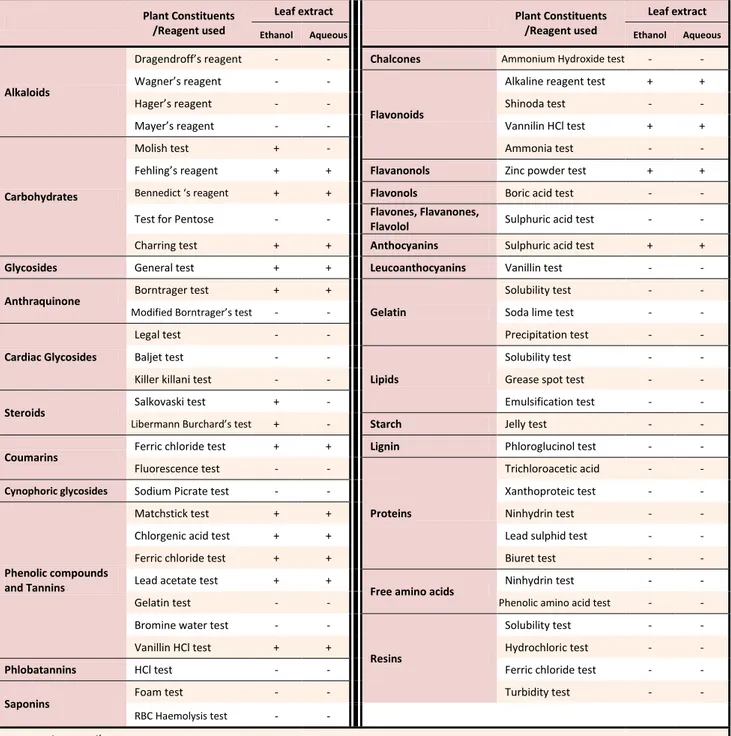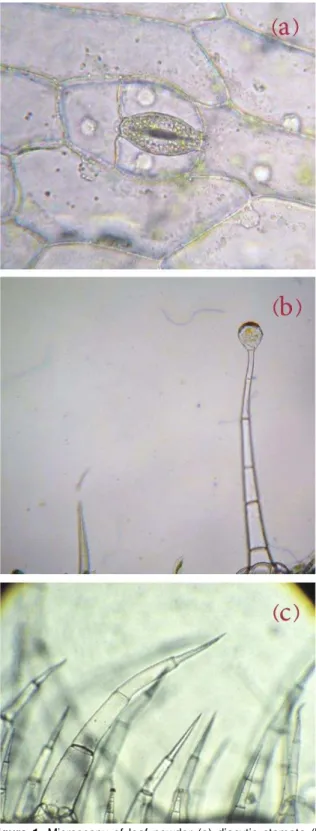Advanced Pharmaceutical Bulletin, 2013, 3(2), 277-281 doi: http://dx.doi.org/10.5681/apb.2013.045
http://apb.tbzmed.ac.ir/
*Corresponding author: Neeru Vasudeva, Department of Pharmaceutical Sciences, Guru Jambheshwer University of Science and Technology,
Oreganum vulgare
Linn. leaf: An Extensive Pharmacognostical and
Phytochemical Quality Assessment
Veni Bharti, Neeru Vasudeva*
Department of Pharmaceutical Sciences, Guru Jambheshwer University of Science and Technology, Hisar, Haryana, India.
Introduction
The use of medicines from natural resources is as old as evolutionary history of human being. Primitive man started using these herbs by hit and trial method and distinguished whether which combination of herbs is effective in treating any ailment or which is exerting toxicity. Plants are defined as „biochemical factories‟ producing bio-chemicals responsible for therapeutic activity or toxicological effect. 80% of the world‟s population especially in developing countries is dependent on herbal medicines because of less side effects, easy availability and economic.1,2 Herbal drugs are still at the risk of quality because sources of raw material of herbal drugs are different and an herb is mixture of multi-constituents, and lack of availability of efficient analytical methods. Hence, it is necessary to set official standards to maintain quality, the first step of which must be identification of entire constituents and physicochemical parameters in herbs.3
Oreganum vulgare Linn. (Lamiaceae) commonly known as Oregano, is used traditionally as expectorant and spasmolitic agent, as diuretic and antiseptic agent and in dermatological affections.4,5 In the present paper an attempt was made to standardize and identify phytochemical profile.
Materials and Methods
Plant material
Oreganum vulgare leaves were procured from Aum Agreefresh Pvt. Ltd. and were identified by the same company. The voucher specimen (Pcog1101) was deposited in Department of Pharmaceutical sciences,
Guru Jambheshwar University of Science & Technology for future references. The leaves were powdered with the help of a pulvarizer and used for all the studies.
Pharmacognostical Evaluation
Morphological characters like colour, surface texture, odour were examined according to Trease. 6 Organoleptic evaluation, physicochemical parameters viz; ash values, extractive values, heavy metals, microbial counts, phytochemical screening was performed.6-11
Transverse section of leaf was performed by free hand sectioning. The transverse sections and coarsely powdered leaves were cleared with chloral hydrate, stained with phloroglucinol and concentrated HCl, mounted in glycerol and studied under microscope for transverse section and powder studies respectively. Both ethanol and aqueous extracts were analysed for nine elements by atomic absorption microscopy.10
Phytochemical screening
For phytochemical screening, aqueous extract was prepared by soaking 20 g of crude drug with 200 ml of distilled water and kept for 24 h. the extract was filtered and concentrated in rotary vacuum evaporator. Ethanol extract was prepared by soaking 20 g of crude drug with 200 ml of ethanol and kept for 24 h. the extract was filtered and concentrated in rotary vacuum evaporator.
A R T I C L E I N F O A B S T R A C T
Article Type: Research Article
Article History: Received: 1 January 2013 Revised: 5 February 2013 Accepted: 6 February 2013 ePublished: 20 August 2013
Keywords:
Oreganum vulgare Linn. Phytochemical screening Standardization Traditional medicine
Bharti and Vasudeva
Both the extracts were tested for presence of different chemical constituents viz. alkaloids, glycosides, carbohydrates, sterols, phenolic compounds, tannins,
flavonoids, saponins, proteins and free amino acids (Table 1).12-14
Table 1. Preliminary phytochemical screening of ethanol and aqueous extracts
Plant Constituents /Reagent used
Leaf extract Plant Constituents
/Reagent used
Leaf extract
Ethanol Aqueous Ethanol Aqueous
Alkaloids
Drage droff s reage t - - Chalcones Ammonium Hydroxide test - -
Wag er s reage t - -
Flavonoids
Alkaline reagent test + +
Hager s reage t - - Shinoda test - -
Mayer s reage t - - Vannilin HCl test + +
Carbohydrates
Molish test + - Ammonia test - -
Fehli g s reage t + + Flavanonols Zinc powder test + +
Be edi t s reage t + + Flavonols Boric acid test - -
Test for Pentose - - Flavones, Flavanones,
Flavolol Sulphuric acid test - -
Charring test + + Anthocyanins Sulphuric acid test + +
Glycosides General test + + Leucoanthocyanins Vanillin test - -
Anthraquinone Borntrager test + +
Gelatin
Solubility test - -
Modified Bor trager s test - - Soda lime test - -
Cardiac Glycosides
Legal test - - Precipitation test - - Baljet test - -
Lipids
Solubility test - - Killer killani test - - Grease spot test - -
Steroids
Salkovaski test + - Emulsification test - -
Li er a Bur hard s test + - Starch Jelly test - -
Coumarins
Ferric chloride test + + Lignin Phloroglucinol test - - Fluorescence test - -
Proteins
Trichloroacetic acid - -
Cynophoric glycosides Sodium Picrate test - - Xanthoproteic test - -
Phenolic compounds and Tannins
Matchstick test + + Ninhydrin test - - Chlorgenic acid test + + Lead sulphid test - - Ferric chloride test + + Biuret test - - Lead acetate test + +
Free amino acids
Ninhydrin test - - Gelatin test - - Phenolic amino acid test - - Bromine water test - -
Resins
Solubility test - - Vanillin HCl test + + Hydrochloric test - -
Phlobatannins HCl test - - Ferric chloride test - -
Saponins
Foam test - - Turbidity test - -
RBC Haemolysis test - -
+ present, - negative
HPTLC profiling
The solvent system used was Toluene: Ethylacetate (5:1.5). After selecting solvent system for each fraction HPTLC studies was done by using 10×10 cm of glass Plates, CAMAG TLC Scanner3 ”Scanner3_130716 (1.14.26) attached with UV detector of D2 &W lamp with 281 V, second order optical fibre at 366 nm and controlled by win CATS software.15
Results
Pharmacognostic Evaluation Macroscopic examination
Pharmacognostic studies on Oreganum vulgare
Microscopy of leaf powder
Microscopic examination of leaf powder showed the presence of diacytic stomata, glandular and non- glandular trichomes (Figure 1).
Figure 1. Microscopy of leaf powder (a) diacytic stomata (b) trichomes (c) non-glandular trichomes.
Microscopy (T.S. of leaf)
The transverse section of leaf showed the presence of single layered epidermis with multicellular epidermal hairs, a layer of cuticle and amphistomatic stomata
were observed. There was clear cut discrimination between palisade and spongy Parenchymatous cells of Mesophyll. The palisade cells were single layered and columnar. Spongy cells were found to be scattered and loosely arranged. Vascular bundles were conjoint, collateral and closed (Figure 2).
Figure 2. Microscopy T.S. of leaf (a= trichome, b= epidermis, c= mesophyll, d= palisade cells, e= xylem vessel, f= phloem, g= collenchyma).
Determination of physicochemical parameters
The physicochemical parameters total ash, acid insoluble ash, water soluble ash and sulphated ash were found to be 11.5%, 11%, 5, 10.5% w/w respectively. The extractive values of ethanol extract and aqueous extract by hot extraction method were found to be 0.003% and 0.02% w/w respectively and that of by cold extraction method were found to be 0.003%, 0.02% w/w respectively. Swelling index was found to be zero. The drug was not found to be bitter. The foaming index was found to be <100. The % moisture content was found to be 6%. % of volatile oil was found to be 1.67% v/w. crude fiber content was found to be 75% w/w.
Elemental analysis
The Atomic absorption spectroscopy study showed the presence of lead, cadmium, zinc, cobalt, manganese, nickel and copper in ethanol and aqueous extract of leaf but below the permissible limits of WHO and hence are safe to use.
Microbial contamination
The aqueous and ethanol extracts of leaf of Oreganum vulgare showed the complete absence of E.coli, S.typhi, P.aerginosa, S.aureus, Clostridia, Shigella. Total bacterial count was found to be <103 and <104 for ethanol and aqueous extracts respectively.
Preliminary phytochemical screening
Bharti and Vasudeva
lignin, starch, resins, free amino acids and lipids were absent in both ethanol and aqueous extracts.
HPTLC studies
HPTLC profile was developed for ethanol extract of leaf as a preliminary fingerprinting of the extract. Toluene: ethylacetate (5:1.5) was found to be a suitable solvent system for the separation of constituents of leaf extract. Ten spots were observed in HPTLC profiling
of ethanol extract of Oreganum vulgare at 254 nm with Rf values of 0.15, 0.16, 0.26, 0.51, 0.58, 0.66, 0.71, 0.75, 0.83 and 0.89 respectively while fifteen spots were observed at 366 nm with Rf values of 0.16, 0.18, 0.25, 0.32, 0.36, 0.38, 0.50, 0.56, 0.58, 0.66, 0.71, 0.75, 0.79, 0.83 and 0.93 respectively indicating the presence of different constituents. HPTLC images and data are shown in Figure 3.
Pharmacognostic studies on Oreganum vulgare
Discussion
Oreganum vulgare Linn. belonging to family Lamiaceae is commonly known as “Pizza herb” and is commonly served as food material in Lebanese, Italian and Mexican cuisines. It is a perennial herb, distributed among temperate, tropical and subtropical regions. Microscopic analysis and qualitative parameters are carried out in order to establish appropriate data that can be used in identifying crude drug. The phytochemical screening of the test plant was done for their active components present for their medicinal values. Many of the phytochemical tests showed positive results which render the presence of their active compounds. The Total ash, acid insoluble ash, water-soluble ash values and sulfated ash of leaves were observed to be 11.5%, 11%, 5, 10.5% w/w respectively while in a similar study carried out on stem and leaf of Oreganum vulgare 10.6%, 5.6%, 0.47% and 9.4% w/w respectively. The microscopic and macroscopic features were found to be same in previous and present study.16 The present study provides extensive details about microbial count, heavy metal analysis, HPTLC profiling, phytochemical screening, powder studies and physico-chemical features.
Conclusion
Since the plant, Oreganum vulgare which is also used for the treatment of various diseases and disorders, it is important to standardize it for use as a drug. The pharmacognostic constants for the leaves of this plant, the diagnostic microscopic features and the numerical standardization parameters reported in this work could be useful for the compilation of a suitable monograph for its proper identification.
Conflict of interest
We declare that we do not have any conflict of interest.
Acknowledgements
We are thankful to Department of Pharmaceutical Sciences, Guru Jambheshwer University of Science & Technology, Hisar, India for providing facilities to conduct this research.
References
1. Mukherjee PK. Quality Control of Herbal Drugs: An approach to evaluation of botanicals. 1st ed. New Delhi: Business Horizons; 2002.
2. Bisset NG, Wichtl M. Herbal Drugs and Phytopharmaceuticals. 2nd ed. Boca Raton: CRC Press; 1994.
3. Kunle OF, Egharevba HO, Ahmadu PO. Standardization of herbal medicines - A review. Int J Biodivers Conserv 2012; 4: 101-12.
4. Blumenthal M, Brusse WR, Goldberg A, Gruenwald J, Hall T, Riggins CW, et al.The Complete German Commission E Monographs. Austin TX: American Botanical Council; 1998.
5. Bruneton J. Coumarins. In: Bruneton J, editor. Pharmacognosy, Phytochemistry, Medicincal Plants. Paris: Lavoisier Publishing Inc; 1999. P. 263-7.
6. Trease GE, Evans WC. Pharmacognosy. 12th ed. East Bourne : Bailliere Tindall; 1983.
7. Kokoski CJ, Kokoski RJ, Slama FJ. Fluorescence of powdered vegetable drugs under ultraviolet radiation. J Am Pharm Assoc Am Pharm Assoc (Baltim) 1958;47(10):715-7.
8. Wallis TE. TextBook of Pharmacognosy. 5th ed. New Delhi: CBS Publishers and Distributors; 1985. 9. Government of India. Indian Pharmacopoeia. 4th ed.
New Delhi, India: Controller of Publication; 1996. 10. Who. Quality control methods for herbal materials.
Updated ed. Geneva: World Health Organization; 2011.
11. Brinda PB, Sasikala P, Purusothaman KK. Pharmacognostic studies on Merugan kizhangu. Bull Med Eth bot Res 1981; 3: 884-96.
12. Goyal RK, Shah SA, Mehta AA. Practicals in Biochemistry and Clinical Pathology. 1st ed. Ahmedabad : Shah prakashan; 1997.
13. Kokate CK. Practical Pharmacognosy. 4th ed. New Delhi: Vallabh Prakashan; 1994.
14. Kar A. Pharmacognosy and
Pharmaco-biotechnology. New Delhi: New Age International (P) Ltd.; 2003.
15. Sethi PD. High performance thin layer chromatography: Quantitative analysis of pharmaceutical formulations. New Delhi: CBS Publishers; 1996.


